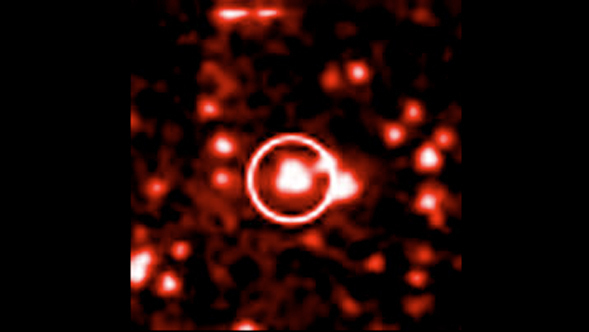
News Release • December 11th, 2006 • feature06-36 •
Written by Linda Vu
Spitzer Science Center
Have supermassive black holes changed since the dawn of our Universe nearly 14 billion years ago?
This question has stumped astronomers for decades. However, thanks to NASA's infrared eyes in the sky -- the Spitzer Space Telescope -- scientists may be one-step closer to solving this mystery.
"Before Spitzer, people didn't know about the infrared properties of quasars [or supermassive black holes] in the very early Universe. With Spitzer, we have detected infrared light from 13 quasars that formed within the Universe's first billion years," says graduate student Linhua Jiang, of the University of Arizona, Tucson.
Jiang recently authored a paper on Spitzer's observation of 13 distant quasars, each formed approximately 13 billion years ago. His paper was published in the November 2006 issue of Astronomical Journal.
In the infrared, astronomers can tell if a ring of dust is shrouding a particular quasar. Using Spitzer, Jiang discovered dust around 11 quasars in his sample, and determined that they share similar infrared properties to quasars that formed relatively recently.
"The conditions of the Universe in its first billion years are very different from the current conditions of the Universe, so it is very surprising that many quasars of the early Universe look very similar to their modern counterparts," says to Dr. Xiaohui Fan, also of the University of Arizona and a co-author on the paper.
According to Jiang, the two other distant supermassive black holes in his sample have very low infrared emission -- indicating they may lack dust, or have very different dust structures than the other 11 distant quasars observed. These oddballs also do not resemble any modern supermassive black holes. Both Jiang and Fan suspect that the two oddball quasars may offer insights into how supermassive black holes have changed over time.
Astronomers can compare quasars that formed in the early Universe to those that formed relatively recently because of the physics of light travel. Physics dictates that the farther away an object is, the longer it takes for its light to travel to Earth. When the light finally reaches our telescopes, we are essentially seeing it the way it looked when it originally left the object millions or billions of years ago. By comparing Spitzer observations of very distant supermassive black holes to observations of nearby counterparts, Jiang and his team can compare the infrared properties of quasars in the early Universe to those that formed relatively recently.
According to Jiang, previous comparisons of distant and nearby quasars at X-ray and ultraviolet light also show similarities. In X-ray light astronomers can tell if a particular black hole is actively "gobbling up" cosmic debris.
"The X-ray observations showed that it doesn't take very long for quasars to start accreting [or gobbling up] material," said Jiang. "The Spitzer observations extend this intriguing finding into the infrared for 11 quasars in our sample, and show that it doesn't take long for thick rings of dust to gather around a quasar."
"What Spitzer provides is a snapshot into one stage of a quasar's development," says Fan. "We know that quasars played a very important role in the development of galaxies, we are just not quite sure if they have changed over time. Spitzer is giving us some insights into this mystery."
"It is really quite impressive that an 85 cm telescope can see some of the most distant objects in the Universe without difficulty," Fan adds.



